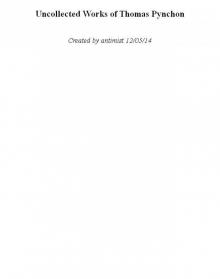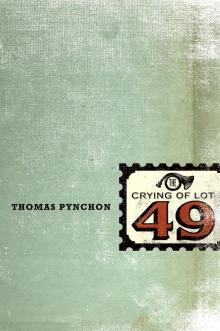- Home
- Thomas Pynchon
Gravity's Rainbow Page 12
Gravity's Rainbow Read online
Page 12
“Precise-ly why,” leaps Rózsavölgyi, “we are now proposing, to give, Sloth-rop a completely different sort, of test. We are now design-ing for him, a so-called, ‘projec-tive’ test. The most famil-iar exam-ple of the type, is the Rorschach ink-blot. The ba-sic theory, is, that when given an unstruc-tured stimulus, some shape-less blob of exper-ience, the subject, will seek to impose, struc-ture on it. How, he goes a-bout struc-turing this blob, will reflect his needs, his hopes—will provide, us with clues, to his dreams, fan-tasies, the deepest re-gions of his mind.” Eyebrows going a mile a minute, extraordinarily fluid and graceful hand gestures, resembling—most likely it is deliberate, and who can blame Rosie for trying to cash in—those of his most famous compatriot, though there’re the inevitable bad side-effects: staff who swear they’ve seen him crawling headfirst down the north façade of “The White Visitation,” for example. “So we are re-ally, quite, in agreement, Reverend Doctor. A test, like the MMPI, is, in this respect, not adequate. It is, a struc-tured stimulus. The sub-ject can fal-sify, consciously, or repress, un-consciously. But with the projec-tive technique, nothing he can do, con-scious or otherwise, can pre-vent us, from finding what we wish, to know. We, are in control. He, cannot help, himself.”
“Must say it doesn’t sound like your cup of tea, Pointsman,” smiles Dr. Aaron Throwster. “Your stimuli are more the structured sort, aren’t they?”
“Let’s say I find a certain shameful fascination.”
“Let’s not. Don’t tell me you’re going to keep your fine Pavlovian hand completely out of this.”
“Well, not completely, Throwster, no. Since you’ve brought it up. We also happen to have in mind a very structured stimulus. Same one, in fact, that got us interested to begin with. We want to expose Slothrop to the German rocket. . . .”
Overhead, on the molded plaster ceiling, Methodist versions of Christ’s kingdom swarm: lions cuddle with lambs, fruit spills lushly and without pause into the arms and about the feet of gentlemen and ladies, swains and milkmaids. No one’s expression is quite right. The wee creatures leer, the fiercer beasts have a drugged or sedated look, and none of the humans have any eye-contact at all. The ceilings of “The White Visitation” aren’t the only erratic thing about the place, either. It is a classic “folly,” all right. The buttery was designed as an Arabian harem in miniature, for reasons we can only guess at today, full of silks, fretwork and peepholes. One of the libraries served, for a time, as a wallow, the floor dropped three feet and replaced with mud up to the thresholds for giant Gloucestershire Old Spots to frolic, oink, and cool their summers in, to stare at the shelves of buckram books and wonder if they’d be good eating. Whig eccentricity is carried in this house to most unhealthy extremes. The rooms are triangular, spherical, walled up into mazes. Portraits, studies in genetic curiosity, gape and smirk at you from every vantage. The W.C.s contain frescoes of Clive and his elephants stomping the French at Plassy, fountains that depict Salome with the head of John (water gushing out ears, nose, and mouth), floor mosaics in which are tessellated together different versions of Homo Monstrosus, an interesting preoccupation of the time—cyclops, humanoid giraffe, centaur repeated in all directions. Everywhere are archways, grottoes, plaster floral arrangements, walls hung in threadbare velvet or brocade. Balconies give out at unlikely places, overhung with gargoyles whose fangs have fetched not a few newcomers nasty cuts on the head. Even in the worst rains, the monsters only just manage to drool—the rainpipes feeding them are centuries out of repair, running crazed over slates and beneath eaves, past cracked pilasters, dangling Cupids, terra-cotta facing on every floor, along with belvederes, rusticated joints, pseudo-Italian columns, looming minarets, leaning crooked chimneys—from a distance no two observers, no matter how close they stand, see quite the same building in that orgy of self-expression, added to by each succeeding owner, until the present War’s requisitioning. Topiary trees line the drive for a distance before giving way to larch and elm: ducks, bottles, snails, angels, and steeplechase riders they dwindle down the metaled road into their fallow silence, into the shadows under the tunnel of sighing trees. The sentry, a dark figure in white webbing, stands port-arms in your masked headlamps, and you must halt for him. The dogs, engineered and lethal, are watching you from the woods. Presently, as evening comes on, a few bitter flakes of snow begin to fall.
• • • • • • •
Better behave yourself or we’ll send you back to Dr. Jamf!
When Jamf conditioned him, he threw away the stimulus.
Looks like Dr. Jamf’s been by to see your little thing today, hasn’t he?
—Neil Nosepicker’s Book of 50,000 Insults, §6.72, “Awful Offspring,” The Nayland Smith Press, Cambridge (Mass.), 1933
PUDDING: But isn’t this—
POINTSMAN: Sir?
PUDDING: Isn’t it all rather shabby, Pointsman? Meddling with another man’s mind this way?
POINTSMAN: Brigadier, we’re only following in a long line of experiment and questioning. Harvard University, the U.S. Army? Hardly shabby institutions.
PUDDING: We can’t, Pointsman, it’s beastly.
POINTSMAN: But the Americans have already been at him! don’t you see? It’s not as if we’re corrupting a virgin or something—
PUDDING: Do we have to do it because the Americans do it? Must we allow them to corrupt us?
Back around 1920, Dr. Laszlo Jamf opined that if Watson and Rayner could successfully condition their “Infant Albert” into a reflex horror of everything furry, even of his own Mother in a fur boa, then Jamf could certainly do the same thing for his Infant Tyrone, and the baby’s sexual reflex. Jamf was at Harvard that year, visiting from Darmstadt. It was in the early part of his career, before he phased into organic chemistry (to be as fateful a change of field as Kekulé’s own famous switch into chemistry from architecture, a century before). For the experiment he had a slender grant from the National Research Council (under a continuing NRC program of psychological study which had begun during the World War, when methods were needed for selecting officers and classifying draftees). Shoestring funding may have been why Jamf, for his target reflex, chose an infant hardon. Measuring secretions, as Pavlov did, would have meant surgery. Measuring “fear,” the reflex Watson chose, would have brought in too much subjectivity (what’s fear? How much is “a lot”? Who decides, when it’s on-the-spot-in-the-field, and there isn’t time to go through the long slow process of referring it up to the Fear Board?). Instrumentation just wasn’t available in those days. The best he might’ve done was the Larson-Keeler three-variable “lie detector,” but at the time it was still only experimental.
But a hardon, that’s either there, or it isn’t. Binary, elegant. The job of observing it can even be done by a student.
Unconditioned stimulus = stroking penis with antiseptic cotton swab.
Unconditioned response = hardon.
Conditioned stimulus = x.
Conditioned response = hardon whenever x is present, stroking is no longer necessary, all you need is that x.
Uh, x? well, what’s x? Why, it’s the famous “Mystery Stimulus” that’s fascinated generations of behavioral-psychology students, is what it is. The average campus humor magazine carries 1.05 column inches per year on the subject, which ironically is the exact mean length Jamf reported for Infant T.’s erection.
Now ordinarily, according to tradition in these matters, the little sucker would have been de-conditioned. Jamf would have, in Pavlovian terms, “extinguished” the hardon reflex he’d built up, before he let the baby go. Most likely he did. But as Ivan Petrovich himself said, “Not only must we speak of partial or of complete extinction of a conditioned reflex, but we must also realize that extinction can proceed beyond the point of reducing a reflex to zero. We cannot therefore judge the degree of extinction only by the magnitude of the reflex or its
absence, since there can still be a silent extinction beyond the zero.” Italics are Mr. Pointsman’s.
Can a conditioned reflex survive in a man, dormant, over 20 or 30 years? Did Dr. Jamf extinguish only to zero—wait till the infant showed zero hardons in the presence of stimulus x, and then stop? Did he forget—or ignore—the “silent extinction beyond the zero”? If he ignored it, why? Did the National Research Council have anything to say about that?
When Slothrop was discovered, late in 1944, by “The White Visitation”—though many there have always known him as the famous Infant Tyrone—like the New World, different people thought they’d discovered different things.
Roger Mexico thinks it’s a statistical oddity. But he feels the foundations of that discipline trembling a bit now, deeper than oddity ought to drive. Odd, odd, odd—think of the word: such white finality in its closing clap of tongue. It implies moving past the tongue-stop—beyond the zero—and into the other realm. Of course you don’t move past. But you do realize, intellectually, that’s how you ought to be moving.
Rollo Groast thinks it’s precognition. “Slothrop is able to predict when a rocket will fall at a particular place. His survival to date is evidence he’s acted on advance information, and avoided the area at the time the rocket was supposed to fall.” Dr. Groast is not sure how, or even if, sex comes into it.
But Edwin Treacle, that most Freudian of psychical researchers, thinks Slothrop’s gift is psychokinesis. Slothrop is, with the force of his mind, causing the rockets to drop where they do. He may not be physically highballing them about the sky: but maybe he is fooling with the electrical signals inside the rocket’s guidance system. However he’s doing it, sex does come into Dr. Treacle’s theory. “He subconsciously needs to abolish all trace of the sexual Other, whom he symbolizes on his map, most significantly, as a star, that anal-sadistic emblem of classroom success which so permeates elementary education in America. . . .”
It’s the map that spooks them all, the map Slothrop’s been keeping on his girls. The stars fall in a Poisson distribution, just like the rocket strikes on Roger Mexico’s map of the Robot Blitz.
But, well, it’s a bit more than the distribution. The two patterns also happen to be identical. They match up square for square. The slides that Teddy Bloat’s been taking of Slothrop’s map have been projected onto Roger’s, and the two images, girl-stars and rocket-strike circles, demonstrated to coincide.
Helpfully, Slothrop has dated most of his stars. A star always comes before its corresponding rocket strike. The strike can come as quickly as two days, or as slowly as ten. The mean lag is about 4½ days.
Suppose, Pointsman argues, that Jamf’s stimulus x was some loud noise, as it was in the Watson-Rayner experiment. Suppose that, in Slothrop’s case, the hardon reflex wasn’t completely extinguished. In that case he ought to be getting one on at any loud noise that’s preceded by the same kind of ominous buildup he would’ve found in Jamf’s lab—as dogs to this day find in Pointsman’s own lab. That points to the V-1: any doodle close enough to make him jump ought to be giving him an erection: the sound of the motor razzing louder and louder, then the cutoff and silence, suspense building up—then the explosion. Boing, a hardon. But oh, no. Slothrop instead only gets erections when this sequence happens in reverse. Explosion first, then the sound of approach: the V-2.
But the stimulus, somehow, must be the rocket, some precursor wraith, some rocket’s double present for Slothrop in the percentage of smiles on a bus, menstrual cycles being operated upon in some mysterious way—what does make the little doxies do it for free? Are there fluctuations in the sexual market, in pornography or prostitutes, perhaps tying in to prices on the Stock Exchange itself, that we clean-living lot know nothing about? Does news from the front affect the itch between their pretty thighs, does desire grow directly or inversely as the real chance of sudden death—damn it, what cue, right in front of our eyes, that we haven’t the subtlety of heart to see? . . .
But if it’s in the air, right here, right now, then the rockets follow from it, 100% of the time. No exceptions. When we find it, we’ll have shown again the stone determinacy of everything, of every soul. There will be precious little room for any hope at all. You can see how important a discovery like that would be.
They walk down past the snow-drifted kennel runs, Pointsman in Glastonburys and fawn-colored British warm, Mexico wearing a scarf Jessica’s lately knitted him whipping landward a scarlet dragon’s tongue—this day the coldest so far of the winter, 39 degrees of frost. Down to the cliffs, faces freezing, down to the deserted beach. Waves run up, slide away to leave great crescents of ice fine as skin and dazzling in the weak sunlight. The boots of the two men crunch through to sand or shingle. The very bottom of the year. They can hear the guns in Flanders today, all the way across the Channel on the wind. The Abbey’s ruin stands gray and crystal up on the cliff.
Last night, in the house at the edge of the stay-away town, Jessica, snuggling, afloat, just before sleep was to take them, whispered, “Roger . . . what about the girls?” That was all she said. But it brought Roger wide awake. And bone-tired as he was, he lay staring for another hour, wondering about the girls.
Now, knowing he ought to let it go, “Pointsman, what if Edwin Treacle is right? That it’s PK. What if Slothrop’s—not even consciously—making them fall where they do?”
“Well. You lot’d have something then, wouldn’t you.”
“But . . . why should he. If they are falling wherever he’s been—”
“Perhaps he hates women.”
“I’m serious.”
“Mexico. Are you actually worried?”
“I don’t know. Perhaps I wondered if it might tie in, in any way, with your ultraparadoxical phase. Perhaps . . . I want to know what you’re really looking for.”
Above them now throb a flight of B-17s, bound somewhere uncommon today, well out of the usual corridors of flight. Behind these Fortresses the undersides of the cold clouds are blue, and their smooth billows are veined in blue—elsewhere touched with grayed-out pink or purple. . . . Wings and stabilizers are shadowed underneath in dark gray. The shadows softly feather lighter up around curves of fuselage or nacelle. Spinners emerge from hooded dark inside the cowlings, spinning props invisible, the light of the sky catching all vulnerable surfaces a uniform bleak gray. The planes drone along, stately, up in the zero sky, shedding frost as it builds, sowing the sky behind in white ice-furrows, their own color matching certain degrees of cloud, all the tiny windows and openings in soft blackness, the perspex nose shining back forever warped and streaming cloud and sun. Inside it is black obsidian.
Pointsman has been talking about paranoia and the “idea of the opposite.” He has scribbled in The Book exclamation points and how trues all about the margins of Pavlov’s open letter to Janet concerning the sentiments d’emprise, and of Chapter LV, “An Attempt at a Physiological Interpretation of Obsessions and of Paranoia”—he can’t help this bit of rudeness, although the agreement among the seven owners was not to mark up The Book—it was too valuable for that sort of thing, they’d had to put in a guinea apiece. It was sold him on the sly, in the dark, during a Luftwaffe raid (most existing copies had been destroyed in their warehouse early in the Battle of Britain). Pointsman never even saw the seller’s face, the man vanishing into the hoarse auditory dawn of the all-clear, leaving the doctor and The Book, the dumb sheaf already heating up, moistening in his tight hand . . . yes it might have been a rare work of erotica, certainly that coarse hand-set look to the type . . . the crudities in phrasing, as if Dr. Horsley Gantt’s odd translation were in cipher, the plaintext listing shameful delights, criminal transports. . . . And how much of the pretty victim straining against her bonds does Ned Pointsman see in each dog that visits his test stands . . . and aren’t scalpel and probe as decorative, as fine extensions as whip and cane?
Surely the volume preceding The Book—the first Forty-one Lectures—came to him at age 28 like a mandate from the submontane Venus he could not resist: to abandon Harley Street for a journey more and more deviant, deliciously on, into a labyrinth of conditioned-reflex work in which only now, thirteen years along the clew, he’s beginning to circle back, trip across old evidence of having come that path before, here and there to confront consequences of his younger, total embrace. . . . But she did warn him—did she not? was he ever listening?—of the deferred payment, in its full amount. Venus and Ariadne! She seemed worth any price, the labyrinth looking, in those days, too intricate for them—the twilit pimps who made the arrangement between a version of himself, a crypto-Pointsman, and his fate . . . too varied, he thought then, ever to find him in. But he knows now. Too far in, preferring not to face it just yet, he knows that they only wait, stone and sure—these agents of the Syndicate she must also pay—wait in the central chamber, as he draws closer. . . . They own everything: Ariadne, the Minotaur, even, Pointsman fears, himself. He gets flashes of them these days, naked, athletes poised and breathing about the chamber, terrible penises up mineral as their eyes, which glisten with frost or flakes of mica, but not with lust, or for him. It’s only a job they have. . . .
“Pierre Janet—sometimes the man talked like an Oriental mystic. He had no real grasp of the opposites. ‘The act of injuring and the act of being injured are joined in the behavior of the whole injury.’ Speaker and spoken-of, master and slave, virgin and seducer, each pair most conveniently coupled and inseparable—The last refuge of the incorrigibly lazy, Mexico, is just this sort of yang-yin rubbish. One avoids all manner of unpleasant lab work that way, but what has one said?”
“I don’t want to get into a religious argument with you,” absence of sleep has Mexico more cranky today than usual, “but I wonder if you people aren’t a bit too—well, strong, on the virtues of analysis. I mean, once you’ve taken it all apart, fine, I’ll be first to applaud your industry. But other than a lot of bits and pieces lying about, what have you said?”

 Mason & Dixon
Mason & Dixon Against the Day
Against the Day Uncollected Works
Uncollected Works Bleeding Edge
Bleeding Edge Gravity's Rainbow
Gravity's Rainbow The Crying of Lot 49
The Crying of Lot 49 V.
V. Inherent Vice
Inherent Vice Vineland
Vineland